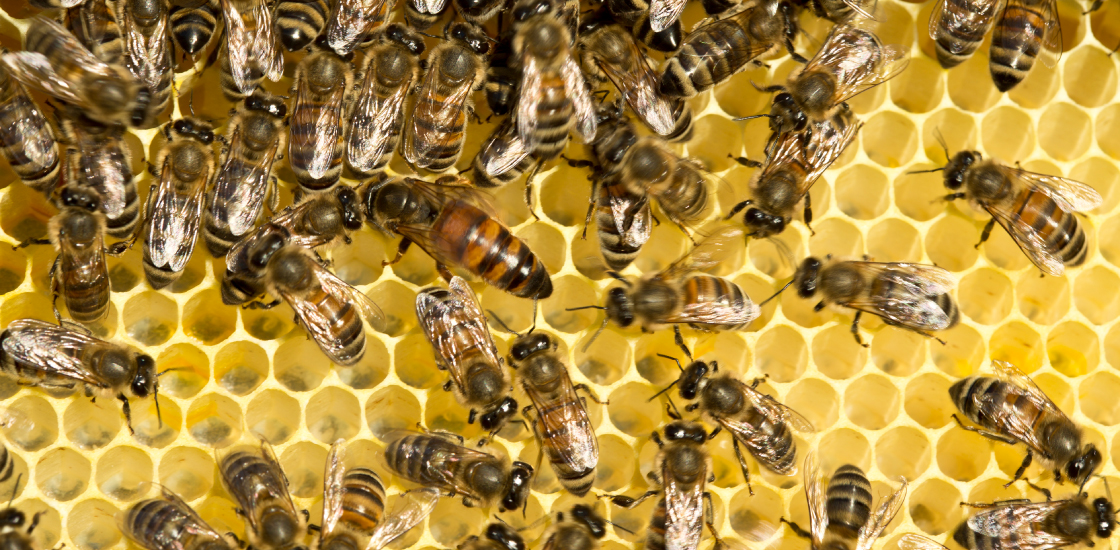‘Antisocial’ bees point to ancient roots for some autism genes
Honey bees that fail certain social tests have genetic profiles similar to those of people with autism.

Honey bees lead intricate social lives: They care for the colony’s young and team up to protect their home, for example. But some bees don’t have ‘hive mind;’ they fail to respond to social cues, such as the arrival of new larvae or trespassing bees.
The genetic profiles of these bees are similar to those of people with autism, according to a provocative study published in July in Proceedings of the National Academy of Sciences USA1.
The researchers identified these bees by giving them two social challenges — reaction to an intruder bee, and care for a queen-bee larva. Their behavior revealed their subsequent role in the hive: Biting and stinging an intruder made them a guard and caring for the larva, a nurse. But some bees did not respond to the challenges, earning themselves the label ‘unresponsive.’
The team compared gene expression in unresponsive bees and in other bees. They found that genes expressed differently in unresponsive bees overlap extensively with genes associated with autism.
We asked Gene Robinson, who led the work, what the findings say about the genetic underpinnings of social behavior and about autism. Robinson directs the Carl R. Woese Institute for Genomic Biology at the University of Illinois at Urbana-Champaign.
Spectrum: What was the goal of this research?
Gene Robinson: The study has to do with looking at whether there are conserved molecular pathways involved in the response to social challenge and social opportunity. We presented the bees with a social challenge, and when we did that, the postdoc who was doing the work, Hagai Shpigler, noticed that some bees did not respond to it.
That wasn’t a real surprise because there’s always a range of responses in behavior. But when Hagai performed the social opportunity assay with the queen larva, he found again that some bees didn’t respond. And so the question quickly became: Are there some bees that don’t respond in either assay?
S: So you stumbled onto a new research question?
GR: Yes. What was interesting was the possibility of connecting this opportunity to one component of autism. But first I want to emphasize that by no means are we saying that autism is only social unresponsiveness. There are other components to autism. We’re not trying to simplify or trivialize what is a very serious condition.
S: How many of the bees were unresponsive?
GR: About 14 percent of the bees we tested showed this unresponsiveness, which is a striking figure. That’s a large number of individuals. This leads to the question: What are they doing in the society?
There are two possible answers. One is that by categorizing the bees as unresponsive we are making the situation too simplistic. Yes, some were unresponsive in our behavioral assays. But under some extreme conditions in the beehive, they might be responsive to these or other stimuli and called into action. We have not ruled that out.
The other possibility is that colonies of honey bees are populous enough that they can tolerate some individuals that do little, if any, work.
S: How did you measure the bees’ complex social life?
GR: Honey bees are highly social animals — social butterflies, you might say. We picked two contexts to explore the issue of social responsiveness. In the laboratory, we created mini-colonies in a clear plastic-covered dish, consisting of 10 individuals that were all from the same original colony. In the first assay, we introduced a foreign bee to each group of 10. Honey bees are able to tell who is related to them and who belongs in their hive, primarily by the odors on their bodies. If one puts an intruder in a beehive, one observes aggression. There are guard bees that lead in the aggressive response toward an intruder. A similar response occurs in the laboratory. We collected the bees responding aggressively to an intruder as well as those that did not respond at all.
In the second assay, we put a queen larva in the mini-colony. Bees typically respond by feeding it intensively and grooming it and taking care of it. We observed ‘nurse’ bees that showed intense levels of response and care to the larva and those that did not respond at all. We also repeated both assays to give bees another chance to respond.
We focused on the bees that did not respond in any of the four trials.
S: What did your genetic analysis show?
GR: More than 1,000 genes showed differences in expression in the brains of the unresponsive group and the two other bee groups: guard or nurse. We took this list of genes as a signature of the unresponsive bees and compared it with a database of genes associated with autism. We found that the genes most strongly associated with autism show a significant overlap with the gene list from the unresponsive bees.
S: What does this work teach us about autism?
GR: There are some genes implicated in autism that have ancient evolutionary roots in social behavior. The genes are involved in the social behavior of two distantly related species. This makes us want to know more about what those genes are doing. The hope is that learning more about how these genes influence social behavior will provide new hints about what happens when they’re not working well.
References:
- Shpigler H.Y. et al. Proc. Natl. Acad. Sci. USA 114, 9653-9658 (2017) PubMed
Recommended reading

Expediting clinical trials for profound autism: Q&A with Matthew State

Too much or too little brain synchrony may underlie autism subtypes
Explore more from The Transmitter

This paper changed my life: Shane Liddelow on two papers that upended astrocyte research
Dean Buonomano explores the concept of time in neuroscience and physics

